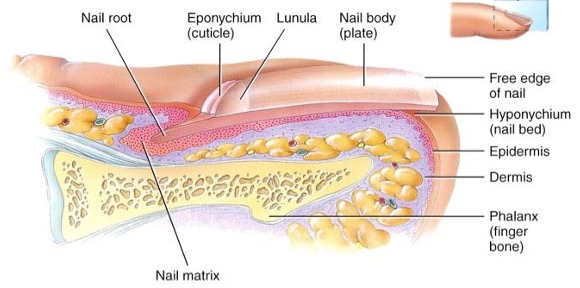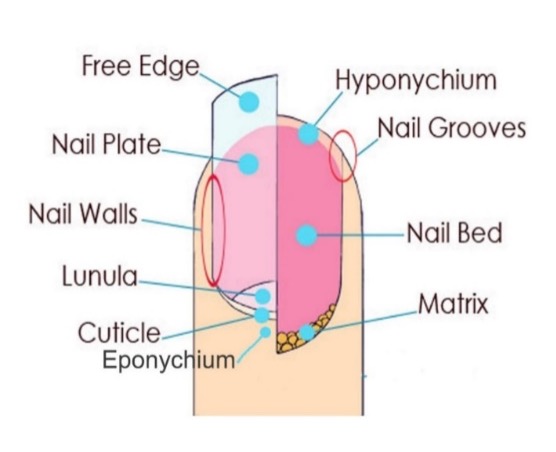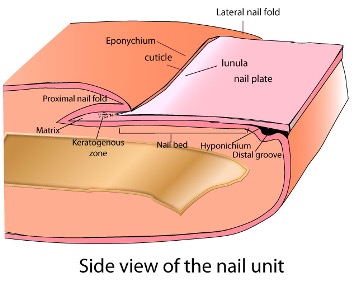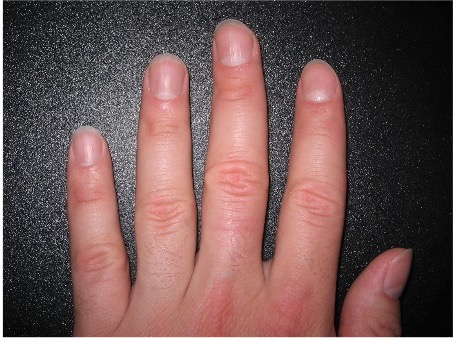Module 1 – Manicure, Pedicure, Gel Polish, Builder in a Bottle
Starting with an understanding of the basics is essential to mastering the art of nail technology. Identifying nail components and the surrounding tissues allows you to provide the best service to your client, from nail prep to homecare.
Structure, growth pattern and composition of the nail
Our body is covered by the epidermis (skin), which provides a protecting physical barrier for all our internal anatomy. The condition of the nail like that of the epidermis, reflects the general health of the body.
Onyx is the technical term for the nail. The normal healthy nail is smooth, shiny and appears slightly pink in colour. Its surface is firm and flexible without any spots, marks or wavy ridges. The nail appendage of the skin is a horny, translucent plate that protects the tips of the fingers and toes. The nail is composed mainly of keratin, a protein substance that forms the base of all horny tissue. Skin and hair are also composed of Keratin. The nail is whitish in appearance and allows the pinkish colour of the nail bed to be seen. The horny nail plate contains no nerve or blood vessels.
The nail consists of three parts:
Nail plate
- The visible portion of the nail that rests on and is attached to the nail bed. The nail plate extends from the root to the free edge.
Nail root
- At the base of the nail and is embedded underneath the skin. It originates from an actively grown tissue known as the matrix.
Free edge
- The end portion of the nail plate that reaches over the fingertip.

1. Free edge
- The part of the nail that extends beyond the fingertip. This is the part that is filed.
- Function: To protect the fingertip and the Hyponychium.
2. Nail plate
- Composed of compact translucent layers of keratinised cells. The layers of cells are packed closely together with fat but little moisture.
- The nail plate makes up the main part of the nail, as the nail grows forward on the nail bed it eventually becomes the free edge.
- The underside of the plate is grooved by ridges and furrows, which help to keep it in place.
- There are no blood vessels or nerves in the nail plate; therefore, the nails like the hair can be cut without pain or bleeding.
- The pink colour of the nail plate is from the blood vessels that pass beneath it.
- In normal health the plate curves in two directions:
i. Transversely-from side to side across the nail.
ii. Longitudinally– from the base of the nail to the free edge.
- Function: To protect the nail bed.
3. Nail wall/fold
- Folds of the skin overlapping the sides of the nail.
- Function: To protect the nail bed.
4. Nail Grooves
- Slits or tracks on the sides of the nail, upon which the nail moves as it grows.
- Function: To keep the nail growing forward in a straight line.
5. Nail bed
- The portion of the skin which the nail plate rests on.
- It has a pattern of grooves and furrows corresponding to those found on the underside of the nail plate.
- The grooves interlock keeping the nail in place but separate at the end of the nail bed to form the free edge.
- It is liberally supplied with blood vessels, which provide the necessary nourishment for continued growth and sensory nerves for protection.
- Function: to supply nourishment and protection.

6. Lunula
- The Lunula is the half moon, located at the base of the nail and is in fact the front end of the matrix.
- The nail plate isn't fully translucent here because the keratin cells are still in the process of compressing and flattening.
- As these cells are exposed, they are easily damaged and can result in a nail disorder known as Leukonychia.
- Function: Has no known function.
7. Cuticle
- Dead skin cells from the eponychium attach to the nail plate as it grows out. This dead skin can be removed with cuticle remover during a manicure.
- Function: Protection, providing a barrier between the nail plate and nail bed.
8. Matrix
- The matrix is found at the base of the nail under the eponychium and is sometimes known as the nail root. It is the growing area of the nail where the process of keratinisation takes place forming the hardened tissues of the nail plate.
- Function: To produce new nail cells.
9. Mantle
- Is a deep fold of skin in which the nail root is embedded It is at the base of the nail above the distal phalanx.
- Function: To protect the matrix from physical damage.
10. Eponychium
- The fold of skin at the base of the nail (cuticle comes from here).
- It consists of living cells and is closely attached to the nail plate.
- This extra growth is often pushed back during a manicure.
- Function: To protect the matrix from infection.
11. Hyponychium
- The Hyponychium is the portion of the epidermis under the free edge of the nail.
- Function: To protect the nail bed from infection.
12. Perionychium
- The Perionychium is the portion of the skin overlapping the sides of the nail.
- Function: To protect the nail.

Exercise One
Match the structure to the definition
|
Structure |
Definition |
|
|
|
Portion of skin between the free edge of the nail and the skin of the fingertip. |
Lunula Nail bed/groove Nail plate Eponychium Matrix Nail wall Free edge Perionychium Hyponychium Mantle Cuticle |
|
|
Folds of skin overlapping the sides of the nail plate for protection. |
|
|
|
Visible portion of the nail which rests on the nail bed (commonly called the fingernail). |
|
|
|
Cuticle at the base of the nail. |
|
|
|
Protects the matrix from infection. |
|
|
|
Only living, reproducing part of the nail. |
|
|
|
Crescent shaped area where the matrix and nail bed meet. |
|
|
|
Extends beyond the end of the skin of the fingertip, part of the nail that is filed. |
|
|
|
Cuticle at the sides of the nail. |
|
|
|
Deep fold of skin at the base of the nail before the cuticle. |
|
|
|
Portion of the finger where the nail plate rests. Contains nerves lymph & blood vessels. |
Your nail grows from the matrix, where the living cells are dividing, as they move up towards the surface of the nail, (just like our skin and hair), they harden and die, becoming the nail plate. The nail plate grows towards the end of the finger, and the free edge is the portion you file into a shape.
The cells of the nail plate and nail bed are produced at the matrix. This is the only living reproducing part of the nail. As new cells are formed, they are pushed forward from the matrix to form the nail plate where they will grow in thickness and length due to the process of keratinisation.
Keratinisation is the change of living cells containing a nucleus into dead, hard cells with no nucleus.
Fingernails grow approximately 3mm per month and toenails approximately 1mm per month.
Did you know?
- Nail growth is influenced by nutrition, health and disease.
- The average growing rate of nails is faster in the summer than in winter.
- Children's nails grow faster than elderly persons.
- Nails grow fastest on the middle finger and slowest on the thumb.
- Toenails grow slower but are thicker and harder.
Often the nails on the hand you use the most, i.e. dominant hand, grow faster. As you use this hand the most, the circulation is usually better, encouraging faster growth. Nails grow faster in summer than winter, as the months are warmer, our circulation is better. Nails take approximately six months to grow from the matrix to the free edge.
Little or minimal activity can contribute to a slower or poor circulation, toenails grow slower than fingernails; they are at the bottom of the circulatory system.
Three characteristics of healthy nails:
- Smooth
- Shiny
- Pink

Factors that influence nail growth
Age
Nails grow quicker in younger people, they are usually very active, especially children. As we age cell activity slows and circulation is not as good, slowing nail growth.
Health
Diseases or disorders, medication and illness can affect our internal systems, which can affect circulation and nail growth.
Damage
Damage to the matrix can impact nail growth, slowing or distorting the nail.
Diet
What we put into our body often shows on the outside, if our diet is poor this can affect nail growth, weakness and health.
Pregnancy
Nails often grow faster during pregnancy due to an increased circulation.
Gender
Nails grow more quickly on men than women.